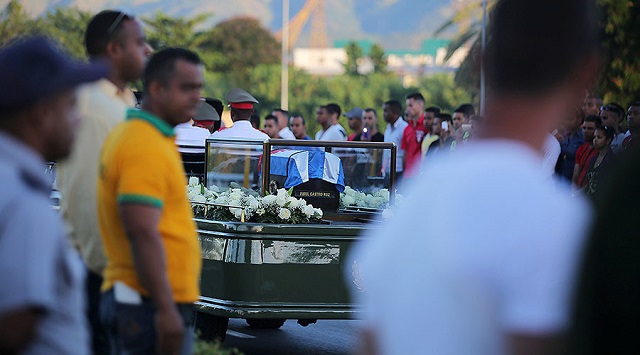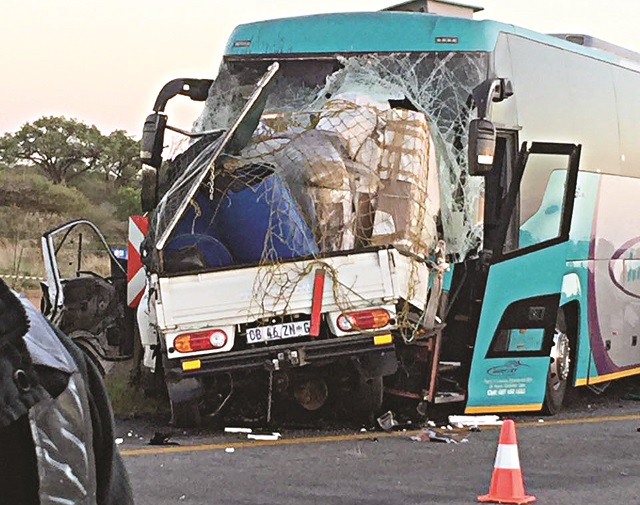Castro’s ashes buried in Santiago


People watch the cortege carrying the ashes of Cuba’s former President Fidel Castro drive toward Santa
Fidel Castro’s ashes were interred yesterday at a cemetery in the southeastern city of Santiago — the cradle of the Cuban revolution — with the military firing a 21-gun salute for their fallen leader.
Initially the act at the cemetery was due to be carried live on television, but hours before official media announced it would be “solemn and private”.
An urn containing Castro’s ashes was brought by soldiers to the cemetery of Santa Ifigenia in Santiago, 800km south-east of Havana. Thousands of people lined the road, waving Cuban flags and shouting “Long live Fidel!”.
The remains of the man who ruled Cuba for a half-century left the Plaza of the Revolution in the eastern city at 6:39am local time, more than 20 minutes ahead of their scheduled departure.
Al Jazeera’s Lucia Newman, reporting from Santiago, said members of Castro’s family and top government officials close to the former leader attended the private ceremony.
“This is very much a state affair, but the funeral itself is not a state funeral,” Newman said.
Castro, who died on November 25 at age 90, was buried near the mausoleum of 19th century independence icon Jose Marti and other national heroes.
After two days of events in Havana, Castro’s funeral cortege departed on a three-day journey east, retracing the route that the triumphant rebels took upon overthrowing US-backed Fulgencio Batista in 1959.
On Saturday evening, President Raul Castro, his brother and successor, said “millions” had come out to pay tribute.
In keeping with his wishes, Castro’s image will not be immortalised with statues nor will public places be named after him, his brother said on Saturday.
Crowds have greeted the caravan along the whole route, with volunteers sprucing up bridges and houses With his brother at his side, Castro began his revolution on July 26, 1953, with a failed assault on the Moncada barracks in Santiago.
He went on to build a Soviet-sponsored communist state 145km from the United States and survived a half century of US attempts to topple or kill him.
Meanwhile, Castro is remembered around the world as a charismatic revolutionary or a ruthless tyrant, but in his neighbourhood, he was also a friendly old man who used his influence to build a football field for kids, two weeks before his death. Castro lived on the western edge of Havana, in a large complex hidden from view by trees and adjacent to a typical Cuban neighbourhood called Jaimanitas.
Horse-drawn carts pass through occasionally and people socialise outside the dispensary for basic goods on the government’s ration card. The modest homes are a little worn.
One of Castro’s final acts was to order a football pitch built for youth in Jaimanitas, where he periodically stopped his car to talk to the people, according to neighbours.
On the surface, support for Castro seems particularly strong in Jaimanitas, where two women who spoke to Reuters news agency teared up when asked about him a week after his death.
On November 9, Castro stopped his car in the neighbourhood to greet kids playing football in the street, according to several neighbours.
“There’s no other place to play. He was interested in this, asking, ‘What do you mean there’s nowhere to play [football]?’ And the next day they were clearing the field,” said Rafael Sierra (56), a veteran of Cuba’s 1980s involvement in the war in Angola, who said he worked for Castro in logistics.
Jennifer Diaz, a 14-year-old ninth-grader, was able to get a picture of Castro. She proudly displayed the image on her iPad of Castro seated in the back seat of his car alongside his wife, Dalia Soto del Valle.
Yossiel Calvo, a 13-year-old eighth-grader, grew excited when talking about his brush with Castro. “I spoke with him about a month ago,” he said.
“He said he was going to make a [football] field for us, and he did it. They’re working on it now.”
Interior Ministry officials cut short a Reuters visit to the neighbourhood, saying the area was off limits to journalists, but not before neighbours could express appreciation for one last order from “El Comandante”.
“And just like that it was done,” said Miriam LaValle, 62, a retired telecommunications worker. “He kept his word.” — AP










Comments